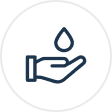
What is Community-Based Water Monitoring?
Community Based Water Monitoring (CBWM) at its foundation is community science. That means the participation of community members in scientific research. These community representatives may not have a formal scientific background nor any Traditional Ecological Knowledge, however they are participating in collecting data, making observations, and contributing to scientific discovery.
-
CBWM is a tool used by communities to track the health of their local watershed, discover pollution sources, and improve decision making. By participating in CBWM, local community members tangibly and holistically become advocates for cleaner water in their region. The capacity these valuable community-members add to data collection allows for large, long-term datasets that can then be used to advocate for cleaner and more accessible water.
While caring for their waters, communities foster their connection to it, leading to an inherent desire to protect it. As community scientists share knowledge with their friends and family, and as they meet with other community scientists at the water’s edge, they build relationships because of the water. Having the water as a core cultural element, means that folks may integrate water connection and protection activities into their daily lives.
How Do We Ensure the Integrity of Our Data?
It is a priority for Swim Drink Fish to only publish highly integral data. We follow a number of quality assurance/ quality control checks to make sure that the data collected by community scientists is credible and usable for the goals of the site and by the broader scientific community. Explore below to see exactly how we make sure the data we publish accurately represents the watershed.
-
Quality Assurance (QA) is a system of activities designed to make sure that our data meets defined standards of quality. This includes the planning, documentation, training, and consistency when collecting and handling samples, analyses, validation, and reporting. Swim Drink Fish's QA procedures include:
Rigorous training protocols for all staff, volunteers, and community- partners (see below for more details)
Provision of visual guides, how-to's, and training videos to continuously support community-partners and volunteers once training is completed
Staff check-ins with community partners and volunteers
All field and laboratory data and documentation stored in paper and electronic formats
-
Quality control (QC) protocols refer to a subset within the larger QA plan that focuses on evaluating, inspecting, and auditing practices. Swim Drink Fish's QC includes:
Field blanks, temperature blanks, and other QC samples according to type of water monitoring and the monitoring plan
Laboratory temperature checks
Technician checks against each other
Sample checks against third-party results
Weekly data checks for everyone in the Swim Drink Fish community
Data sheets are checked over by staff for errors prior to publishing
Our Monitoring Work
Swim Drink Fish has historically focusses on monitoring faecal indicator bacteria. Although indicator bacteria do not necessarily cause illness, they are abundant in human waste where pathogenic organisms are also likely to exist. These indicator bacteria estimate the risk of the presence of other pathogens in the water that would be undetectable on their own. Sewage pollution affects where communities can recreate and harvest shellfish, which are the current focuses of our monitoring.
If your community has a water quality concern outside of the scope of this monitoring, we may still be able to help! We are open to working with communities to develop new monitoring protocols that address your concerns. Reach out to us using the contact information below.
Who is Monitoring?
Swim Drink Fish Hubs
Swim Drink Fish monitors certain sites close to their year-round and summer hubs. These sites are sampled, processed, and analysed by our staff, interns, and volunteers.
-
Swim Drink Fish staff undergo two weeks of training before beginning work. Training includes reading lists, virtual training, along with in-person site visits and water monitoring practice.
Community Partners Hubs
Community partners are those who use our toolkit and monitoring materials for water monitoring in their communities. These partners collect, analyse, and process samples themselves.
-
Community partner hubs undergo a three-day in-person training with staff, along with online training videos, and resources. Staff set up community-partner hubs with all of the spreadsheets, data sheets, and guides to help them along the way. We also schedule regular check-ins and data checks.
Community-Led Sites
Community-led sites are those in which interested community members within the proximity of a hub monitor sites of their interest. Swim Drink Fish staff work with the community group to develop a monitoring plan.
-
Community-led sites consist of a team lead who will join staff for three in-person sample sessions at their site(s) of interest. Staff set up community-led sites with all of the spreadsheets, data sheets, and guides to help them along the way. We also schedule regular check-ins and data checks.





